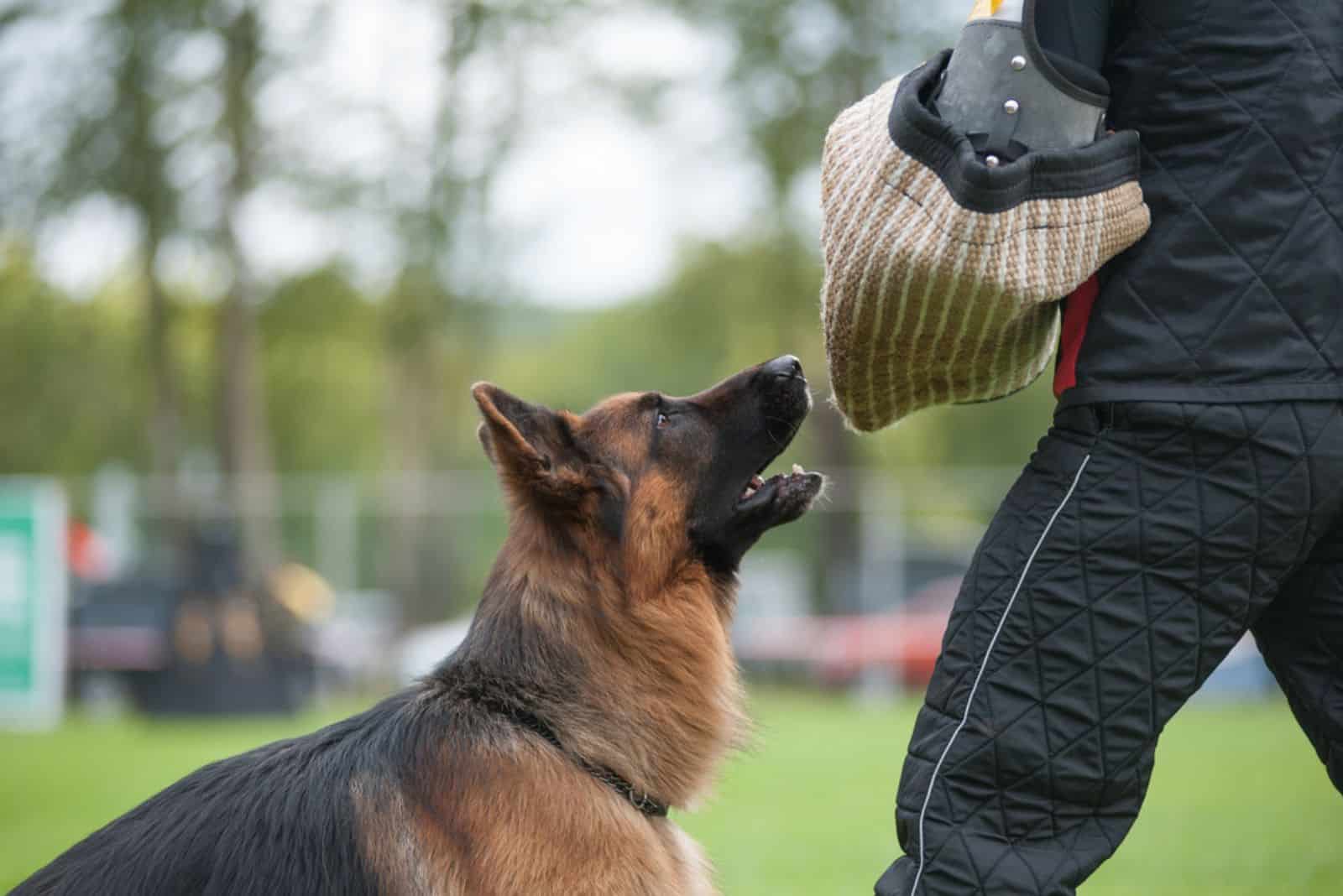German Shepherds are one of the best guard dogs out there which is why so many people want to have one, but they’re also notoriously stubborn and difficult to train which leads to many dog owners wondering how to train a German Shepherd to protect them.
When wondering how to train a German Shepherd to protect you, one simply needs to look into proper training tactics that have already been tried and tested with the breed while also building a strong bond with your furry friend.
A good mix of the two will help establish good discipline while also teaching the dog what’s important to him that will require protecting, in this case being you and your family, as well as the property.
This is a very involved process, one where you’ll need to be consistent in meaning you’ll need to be properly devoted to the training regimen or it may end up falling short at certain steps, leading to an ineffective guard dog.
If you’d like to learn the required steps that most GSD trainers recommend as well as some other tips and tricks regarding the whole process, be sure to read on.
The 6 Main Steps On How To Train A German Shepherd To Protect You
1. Early Socialization

German Shepherds have a notoriously high prey drive due to their history of being Shepherd dogs and that herding nature practically ingrained into their genetics.
This will often lead to your dog trying to ‘herd’ people who are out of line, particularly younger kids which can be a problem in regards to a guard dog intended to protect a family.
Exposing him to socialization at a young age helps teach him how to temper himself around other dogs and kids, as well as strangers so that he doesn’t treat every stranger that enters his sight line as a threat.
The more you do it, the better adjusted your pooch will be as long as he isn’t exposed to too much negativity and will better prepare him to properly react under pressure and emergency situations rather than just being fearful and aggressive to every unfamiliar event.
2. Performing Basic Behavioral Training
As with any dog, basic behavior training is a must if you’re going to get a dog to obey any commands that you give him.
I advise hiring a professional trainer for this rather than doing it alone, particularly if you’re a first time dog owner as, while a relatively common step, it’s one of the most crucial ones to get right so the other steps can follow along.
The person in question will advise you on proper training methods and the way you’re supposed to perform them, and with what attitude.
Positive reinforcement will be the key factor here as the training needs to not be perceived as a chore, but rather a fun activity with you.
It works on the principle that you’re rewarding them for the behavior that you want them to do, but not encouraging any form of bad behavior in return.
This also involves not using any form of physical or verbal punishment that’s considered abrasive and unproductive to a dog’s development.
This way, you’re not only building his levels of trust and obedience, but you’re also building your bond as his guide and the person to follow and rely on if need be.
If you think that it’s a lofty goal to reach, it is, however, German Shepherds are born working dogs and they’re going to enjoy just having something to do and occupy their time which makes the process easier than it first seems.
3. Teaching Him The Basic Commands
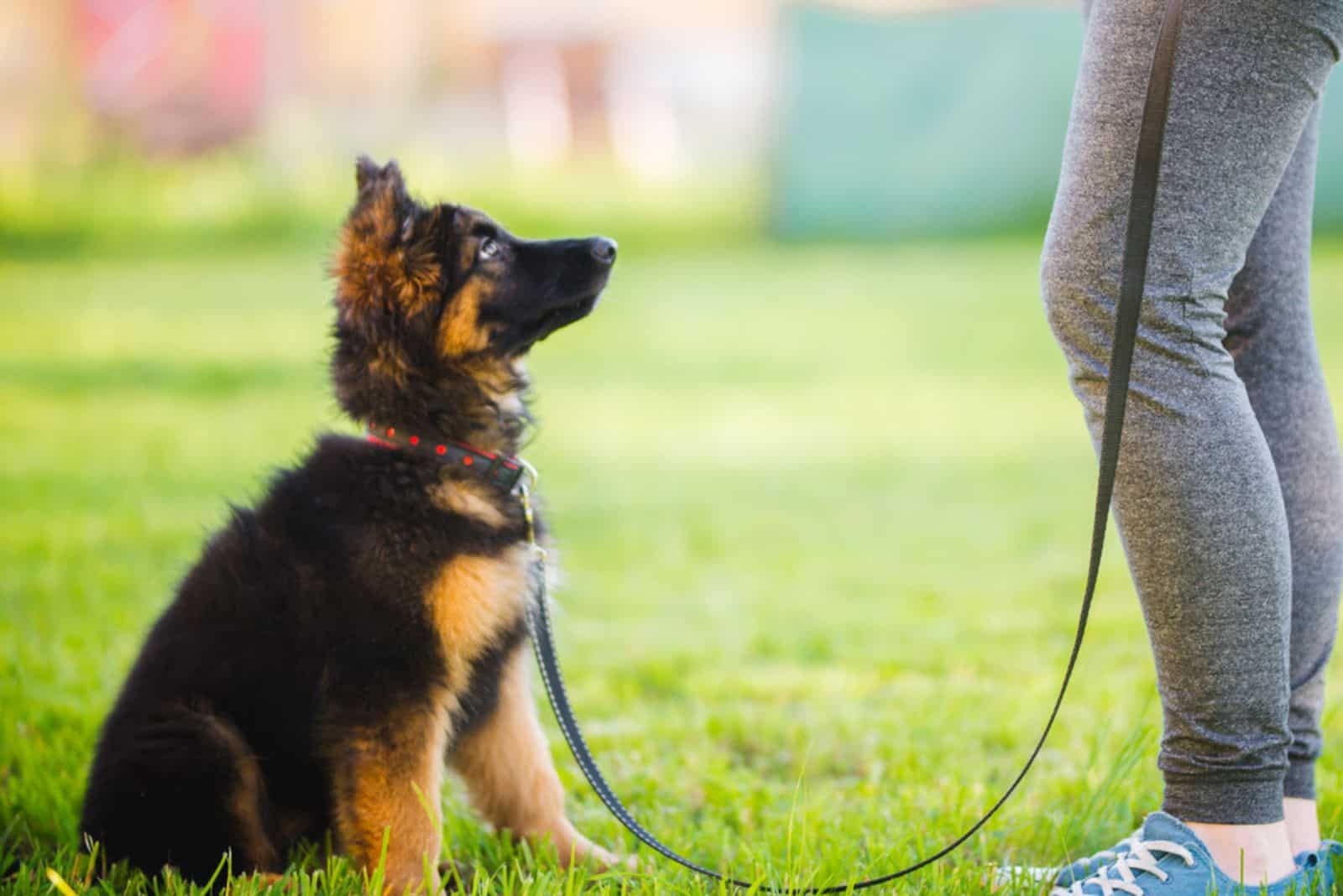
Next up would be getting your dog to obey some basic commands so you can have finer control over his actions as well as further refining what that early socialization has taught him, to know when to bark and when not to.
It normally starts by teaching him how to bark on command, or speak in some cases, giving him a treat every time he responds to the command word and praising him, instilling it as a positive thing in his mind when coming from your mouth.
Once you’ve learned to turn his barking on, you need to install the off switch too, in a sense, by teaching him how to stop when ordered to.
This is followed by another command, people normally use the words “stop” or “quiet”, but it’s personal preference in this matter.
What matters is that you now teach him that the right and productive thing to do when this command is spoken clearly is to stop barking, and give him a treat when he does so, slowly training him to realize this fact.
Once both of these are done, your dog will be ready for the next step.
4. Getting Him To Recognize The Boundaries Of Your Property
Before you tune your dog’s bark further, it’s important to teach him what’s considered your property, or his territory to guard.
To do this, put him on a leash and walk him around the property in question, particularly around the edges, for him to understand what he’s guarding.
You should do this often while he’s young as it’ll make it easier for his brain to adapt to the idea of where the boundaries are down the line.
5. Teaching Him To Bark Directly At Strangers
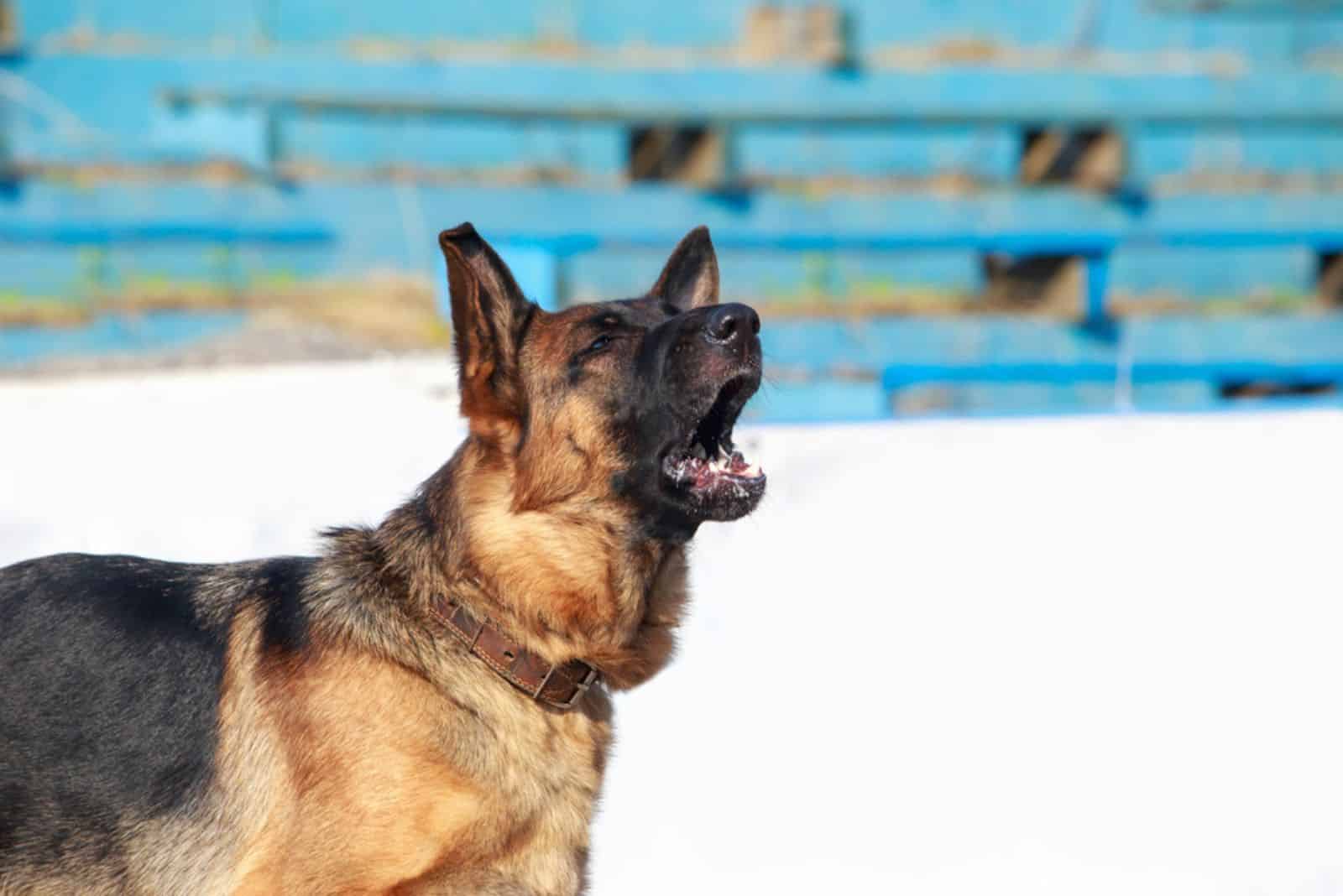
With the perimeter now determined, it’s time to direct the dog’s bark toward strangers.
When he starts barking for whatever reasons, it’s on you to go out to inspect the reason behind it and either reward and praise him if he’s doing it at a stranger coming near or into your home and giving him the command to stop if he’s doing it for an unnecessary reason.
This, of course, extends to walks too, albeit in a different sense. Don’t let him bark at every strange or new person you meet while out as that’s likely to prompt fear from others and may confuse the dog.
You’ve taught him what the boundaries of your home are, and this is your first step in teaching him that he doesn’t need to operate in such a way outside of them.
6. Teaching Him To Bark At Strangers Entering Your Property
Much to the mailman’s dismay, this is the step that may upset him, but it’s one that has to be done as your dog needs to learn not to be bothered by people passing near the property, but rather only those who trespass on it.
To help with this, I advise you get a friend or someone else to help imitate a stranger who’ll intentionally trespass into your home. If taught well, your dog should bark at him regardless.
The intent of the stranger is to help build confidence in the dog by looking back at him and then running away. Once the action is done, you ought to give your dog praise for good behavior and reward him with the same reward process you’ve been handling thus far.
Though, make sure he doesn’t chase after the stranger once he’s out of your property, his only job should be protecting the given perimeter, regardless of circumstance.
You should also give him the command to stop once the intruder is out to better control his bark so it doesn’t needlessly go on even after the stranger is gone. It’s a tool meant to be used as a deterrent, rather than a constant blaring siren that you need to manually turn off.
Not only will it teach him the proper way of the guard dog, but it’ll also instill him with the confidence of a job well done once he knows when it’s time to stop barking and when he can consider the intruder to be put off of trying to trespass further.
That said, don’t encourage your dog to chase after the stranger any further than your property as that may foster some overly aggressive behavior in your German Shepherd.
What Are Some Other Important Tips In Regards To Training A German Shepherd?
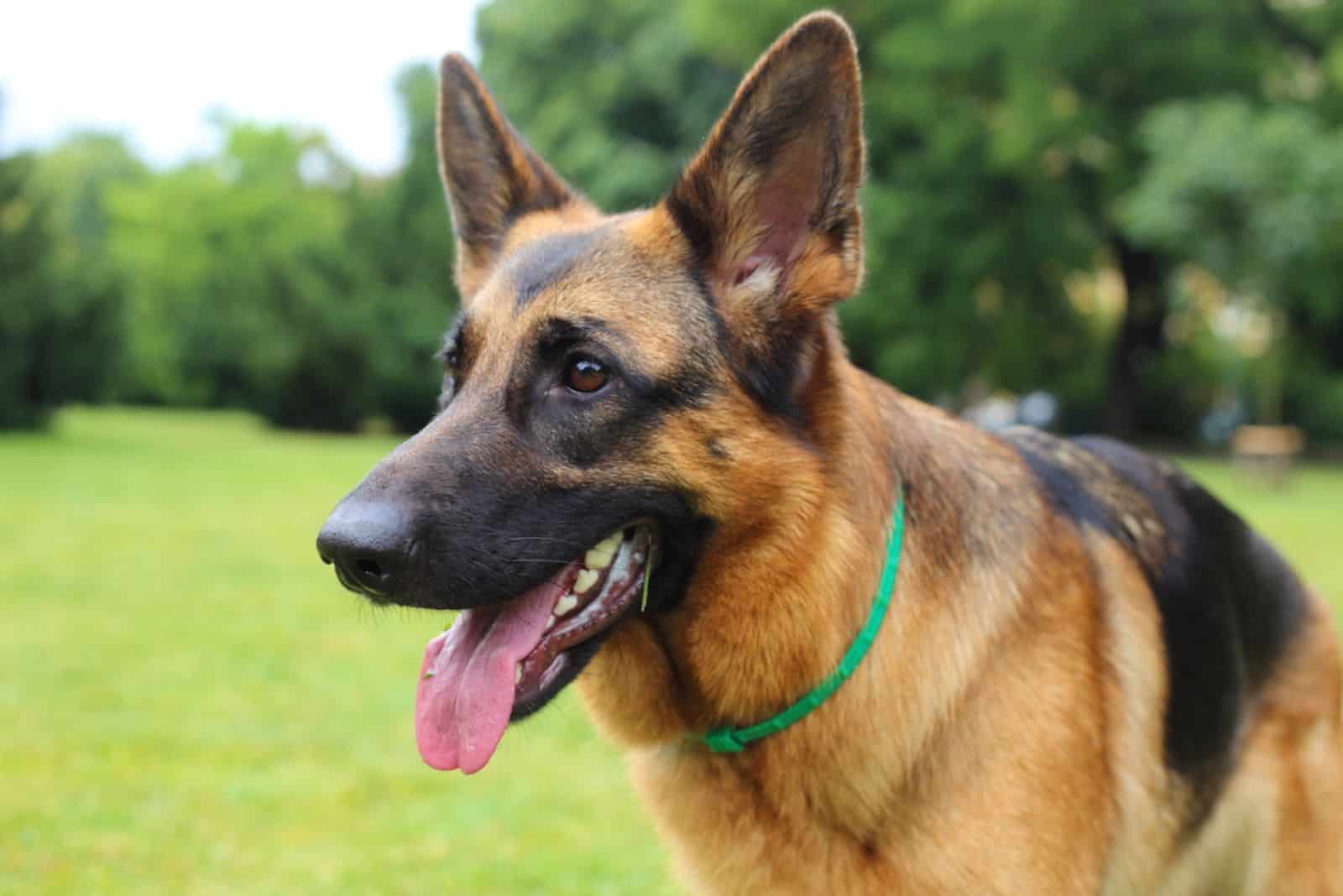
While the top steps mostly cover the basics, what is important is to always appoint yourself as the head of the household, the alpha, so to speak, in comparison to the GSD.
While he may challenge this from time to time, know that as long as you’re firm in the way you treat him and clear in your commands, he’ll respect your authority.
Of course, you should always leave room for affection as German Shepherds are still very social dogs and will thrive better in a more amicable environment.
Also, you won’t have to worry about directly teaching him to protect you as GSDs are naturally protective of their family, human or canine, and their natural instinct will kick in if you’re being threatened.
That said, it’s important to teach him the distinction between an actual attack and a friendly approach so he doesnt lunge at just about anyone, which is why that first step of early socialization is needed to help him understand the nuances of human behavior.
And, finally, never train him to intentionally bite or otherwise permanently harm anyone, as that’s often seen as a crime, even if it’s done in self-defense, and it may result in the loss of your dog.
Just have him pin the attacker down and you handle the rest, though hopefully it never has to come to that.
In Conclusion
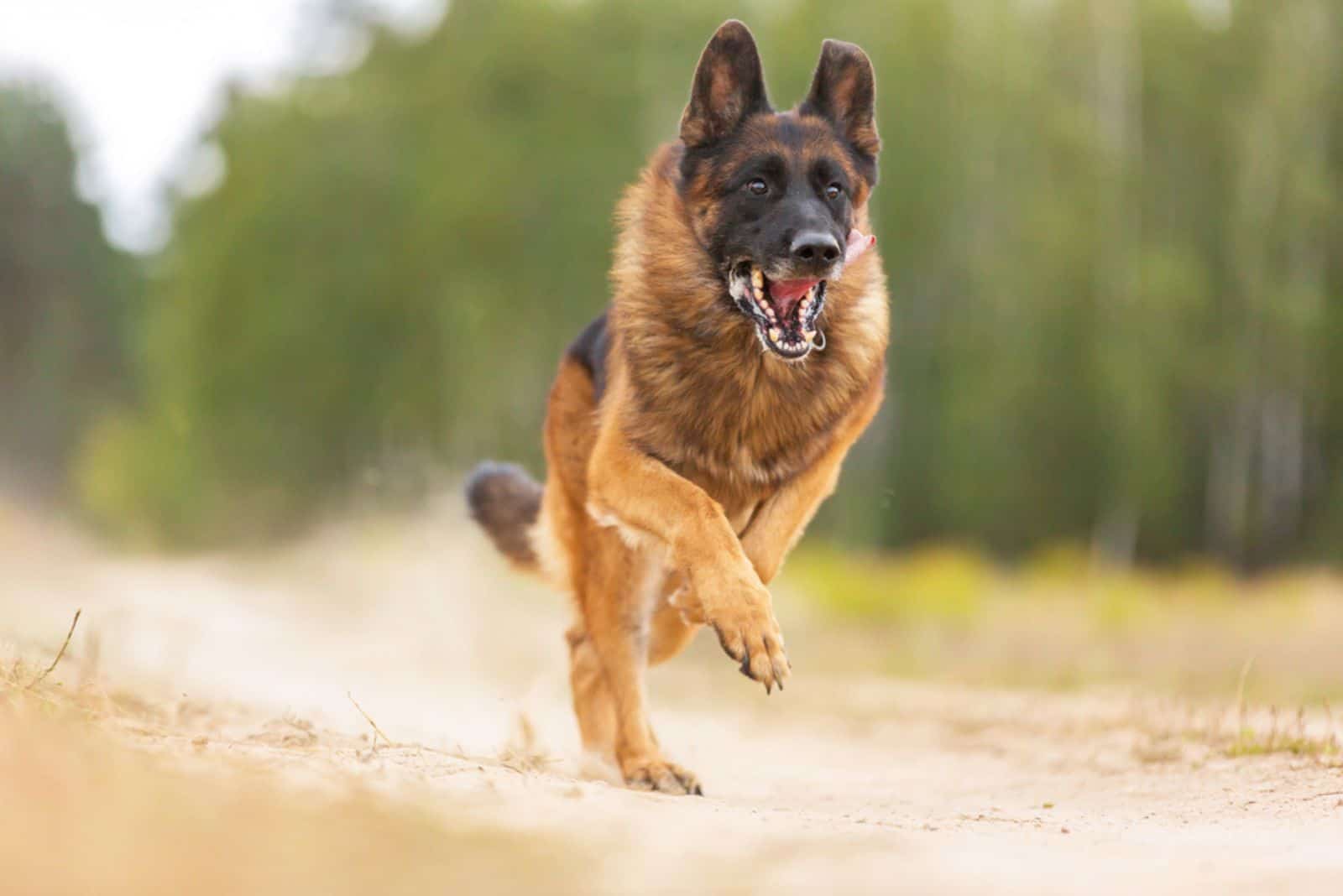
While learning how to train a German Shepherd to protect you may seem simple, there are plenty of intricacies to consider within these steps that you’d need to adhere to.
The most important one is being clear, concise and consistent in your training, forming a pattern that your GSD can follow along easily so as to not confuse him with inconsistent training practices.
This will also help cement you as the dog’s alpha whose orders he’ll be more likely to obey, especially if you’re the one most involved in his training.
Should you ever get lost on a step or are unsure on how to proceed, there’s no shame in calling a professional dog trainer to help out, it’s their job to do so after all.
That said, I do have full confidence that you’ll be able to properly train your furry friend to be the best guard dog he can be. Until next time, pet parents.
RELATED LINKS:
